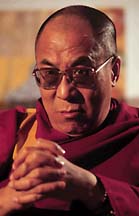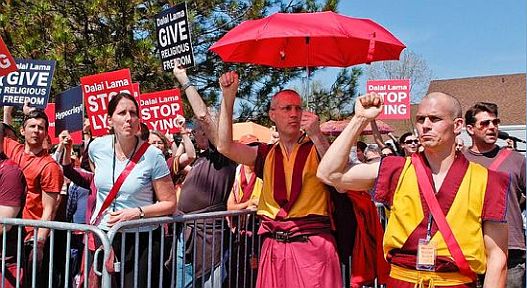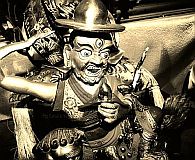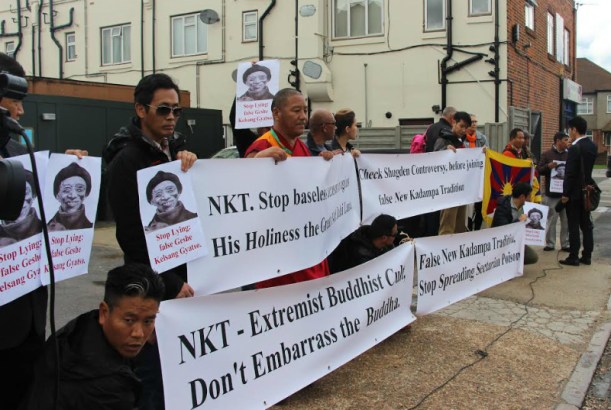Dalai Lama
 The Dalai Lama is the saintly head of Tibetan Buddhism, the umpteenth reincarnation of the Buddha who has ruled Tibet,
the spiritual Shangri-La in the Himalayas, since time immemorial. There the poor but saintly and ever so happy peasants toil
cheerfully to support the monasteries in which live the thousands of dedicated monks whose esoteric and magical powers
and deep meditational practices allow them to overcome cold, hunger and gravity while creating the spiritual energy that
keeps this world from turning to the dark side of the force. At least that's the Hollywood version of Tibet.
The Dalai Lama is the saintly head of Tibetan Buddhism, the umpteenth reincarnation of the Buddha who has ruled Tibet,
the spiritual Shangri-La in the Himalayas, since time immemorial. There the poor but saintly and ever so happy peasants toil
cheerfully to support the monasteries in which live the thousands of dedicated monks whose esoteric and magical powers
and deep meditational practices allow them to overcome cold, hunger and gravity while creating the spiritual energy that
keeps this world from turning to the dark side of the force. At least that's the Hollywood version of Tibet.
The historical reality is a little different. Tibetan history is extremely complex, ridden with conflict, violence and power politics intertwined with struggles for religious dominance between the indigenous Bon shamanism and Buddhist sects. The first Dalai Lama was Sonam Gyatso (1543-88), head of the dominant Gelukpa (Yellow Hat) monastic sect. This title was bestowed him by a Mongol chief Altan Khan in 1578 and applied retroactively to his two predecessors so that he is called the third Dalai Lama. Basically the Dalai Lama was a puppet of a foreign power whose aim was to control Tibet's foreign policy without having to waste the expensive military resources that conquest and direct control would require. The 2nd (4th) Dalai Lama was a grandson of this ruler and with the aid of Mongol military force he crushed the Karmapa and Nyingma (Red or Black Hat) sects and became both the spiritual and temporal ruler.
The Dalai Lama appears to be a charming and inquisitive person whose public persona has done a lot create a warm and fuzzy feeling for Tibet in the West. However there is considerable controversy in the Tibetan Buddhist community with many of their "reincarnated" gurus having been involved in sex and drug scandals. There have been violent disputes over just who is the official "reincarnated" tulku and there have been protests against the Dalai Lama.



 Members of the International Shugden Community (New Kadampa Tradition) publicly protested against visits of the Dalai Lama to various countries.
This appears to have arisen from the creation of a new cult in the West based on the person of Kelsang Gyatso who turned a community of Buddhist students into rejecting all other Tibetan lamas
and traditions as sources of authority. This has centered on the worship of an entity called Dorje Shugden, worship of whom was apparently banned by the Dalai Lama because of the "protector's" exclusivist sectarian sentiments. There were even anti-protest protests.
Members of the International Shugden Community (New Kadampa Tradition) publicly protested against visits of the Dalai Lama to various countries.
This appears to have arisen from the creation of a new cult in the West based on the person of Kelsang Gyatso who turned a community of Buddhist students into rejecting all other Tibetan lamas
and traditions as sources of authority. This has centered on the worship of an entity called Dorje Shugden, worship of whom was apparently banned by the Dalai Lama because of the "protector's" exclusivist sectarian sentiments. There were even anti-protest protests.

The Dalai Lama's successors governed Tibet-first as tributaries of the Mongols, but from 1720 to 1911 as vassals of the emperor of China. While the Mongol chiefs and Chinese emperors paid lip-service to Buddhism they never allowed it's tenets to disturb their incessant warfare and conquests. The succession of monastic leaders through so-called reincarnation searches seems to have evolved to prevent the local aristocracy (who were the ones making use of the extra female population) from gaining long term control of the powerful monasteries through use of their own families and is part of the ongoing struggle for political control by the three forces, the Dalai Lamas, the aristocrats and the powerful independant monasteries.
Even though the Dalai Lamas (and other high-ranking monastic rulers)are chosen at a very young age and educated in a rigidly controlled environment their history has not been without scandal. The death of the 5th Dalai Lama was hidden for years so that political control would copntinue. The 6th Dalai Lama was, understandably enough, bored by his monotonous life and took to drunkenness, debauchery and poetry. He was arrested by Chinese troops and died on the way to the Chinese court. The 7th Dalai Lama was able to gain complete political control from the aristocracy. The 9th Dalai Lama died aged 9. The 10th Dalai lama died aged 22 before taking power. The 11th Dalai Lama died aged 18. During this period the regents had power and suspicions that the Dalai Lamas are widely held.
The 14th Dalai Lama, born Tenzin Gyatso, 1935, was installed in 1940. Shortly afterwards his teacher and guardian, a Living Buddha and the divine guru o the Dalai Lama organised a revolt with Chinese help which failed. As no Tibetan wished to kill such a high reincarnated soul he was starved to death in a dungeon. The Chinese Communist forces took control of Tibet in 1950. The Dalai Lama, a boy much interested in Western technology, remained in Tibet until 1959, when he fled to India following an abortive Tibetan revolt. He established a Tibetan government-in-exile in Dharmsala, India, and has worked to preserve Tibetan arts, scriptures, and medicine. In 1989 he was awarded the Nobel Peace Prize for his nonviolent struggle (for which there is no tradition in Tibetan Buddhism) to end Chinese domination of his homeland. Since he fled in 1959, Han Chinese immigration into Tibet has increased to the point where Chinese now outnumber ethnic Tibetans. This population and the strategic military importance of Tibet now make it unlikely that Tibet will ever achieve independance again. It is ironic that the one thing that could have prevented this demographic change was a strong and ongoing guerilla resistance and the one person who prevented this was the last Dalai Lama.
Bibliography:
Avedon, J., In Exile from the Land of Snows (1984)
Burman, B., Religion and Politics in Tibet (1979)
Dalai Lama, My Land and My People (1962), Freedom in Exile (1990), and My Tibet (1990)
Goodman, M. H., The Last Dalai Lama (1986)
Hicks, R., and Chogyam, N., Great Ocean (1990)
Levenson, Claude B., The Dalai Lama: A Biography (1989).
Back to Gurus Page.